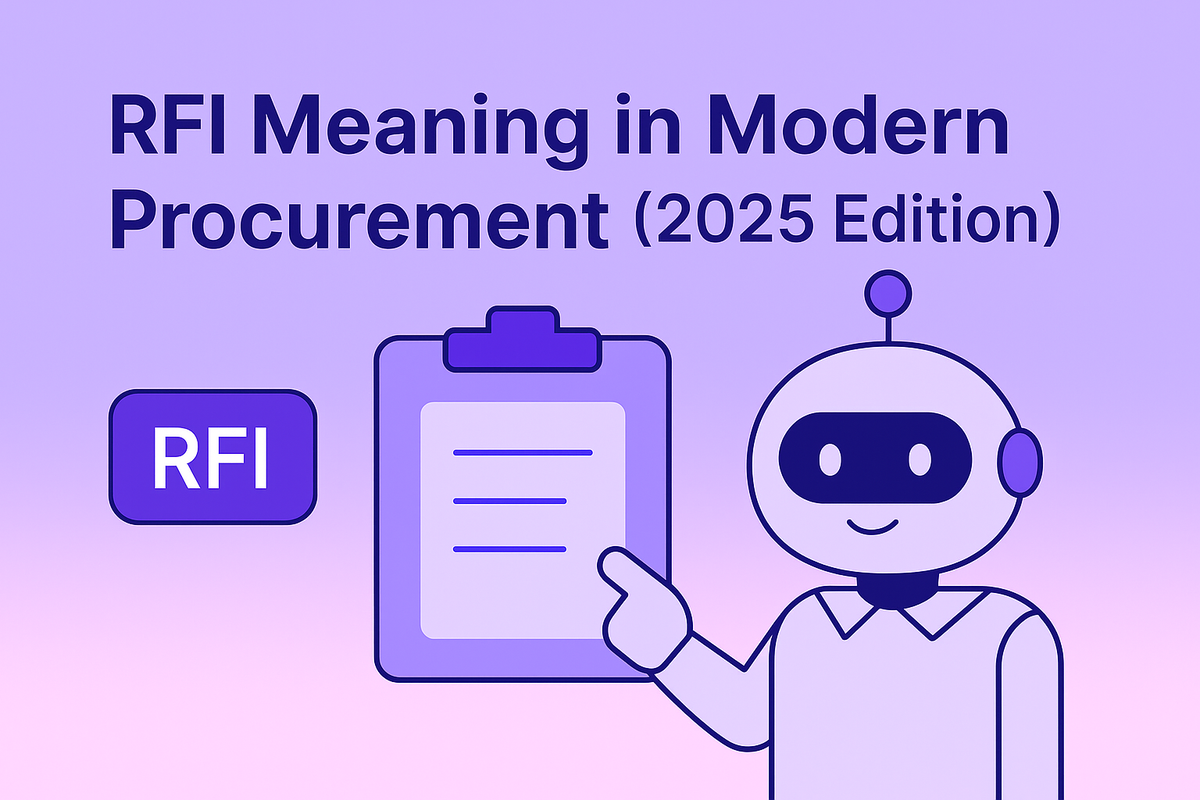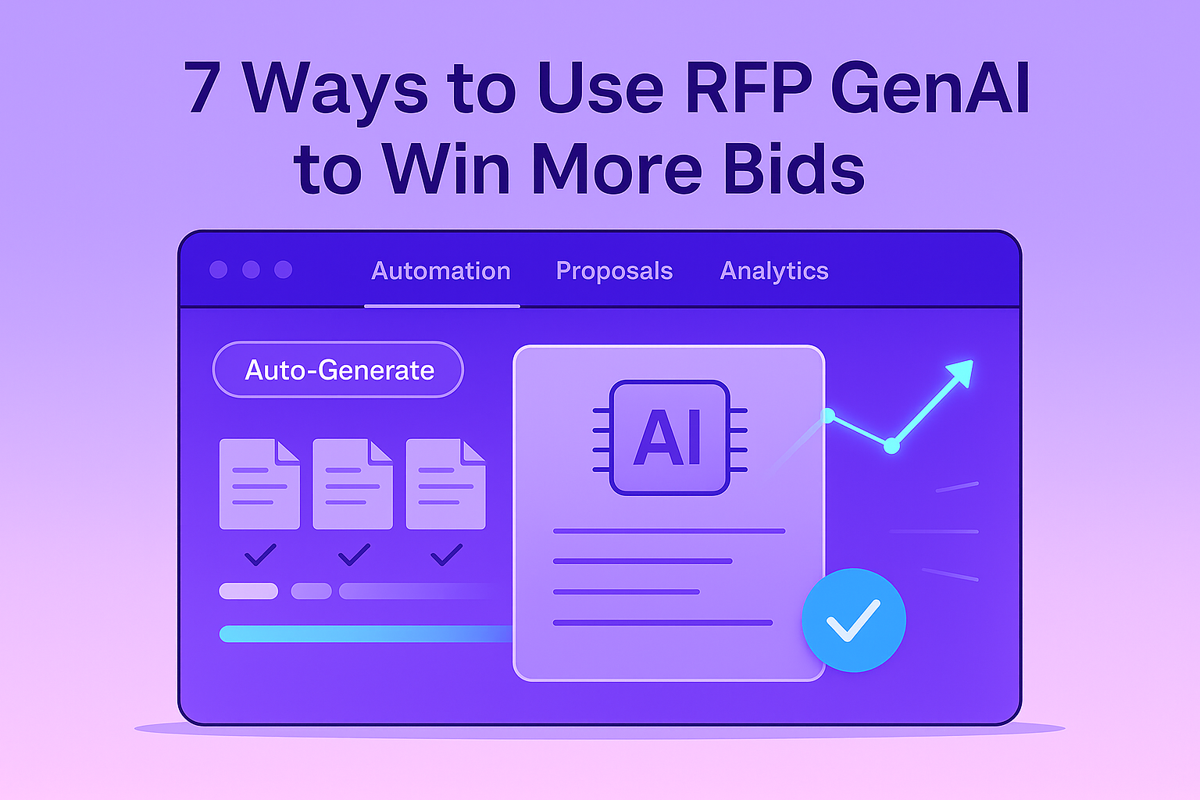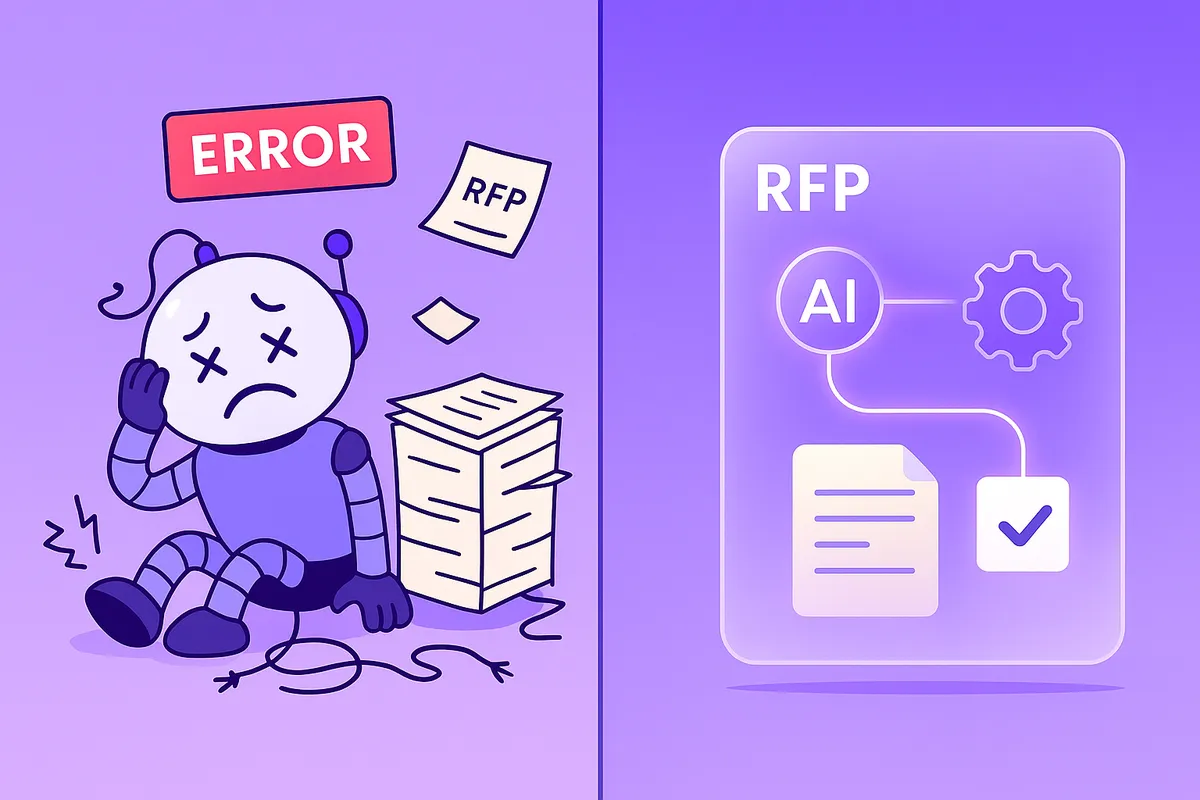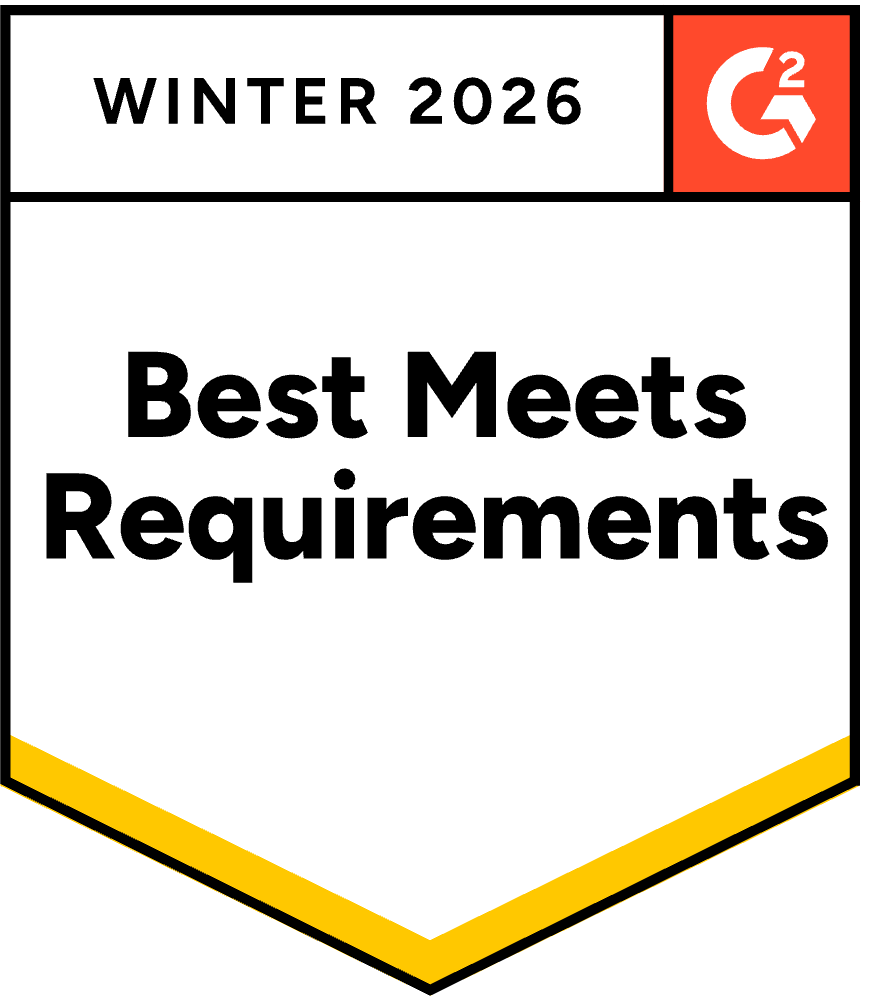RFI Meaning Explained: From Basics to Modern Strategy
October 31, 2025
By
Evie Secilmis

For years, the term RFI was treated as a simple acronym for Request for Information. Today, that definition is dangerously incomplete. In modern enterprise sales, RFIs have become a strategic vendor intelligence process. They are no longer just about what your product does; they’re about your security posture, your AI governance, and your overall business credibility. The true 'rfi meaning' is now a test of vendor readiness. Buyers use it as a critical filter to decide who is capable and secure enough to even receive a full RFP. This guide breaks down the modern RFI, explaining what’s really being asked and how to deliver a response that proves you’re a serious contender.
Why “Request for Information” Now Means Vendor Readiness, AI Capability, and Risk Transparency
For years, “RFI” was treated as a basic acronym — a Request for Information.
Today, that definition is incomplete.
In modern enterprise environments, RFIs are a strategic vendor intelligence process tied to:
- Security and compliance readiness
- AI maturity and governance
- Technical fit and integration depth
- Vendor risk management
- Cross-functional buying cycles
RFIs now help procurement and presales teams determine whether a vendor is capable, credible, and secure before they ever move to an RFP or full evaluation.
For foundational background, you can also explore our RFI glossary definition.
What is a Request for Information (RFI)?
Think of an RFI as the start of a conversation. It’s a formal document a company uses to gather general information from potential suppliers or partners when they're exploring a new project or purchase. They aren't ready to buy just yet; they're in the research phase, trying to understand the landscape of available solutions. An RFI helps them get a feel for what’s out there, who the key players are, and what different approaches exist to solve a potential problem. It’s a low-stakes way for them to collect data without making any commitments, allowing them to educate themselves before moving on to more serious evaluation stages.
The Fundamental Definition
At its core, a Request for Information is exactly what it sounds like: a formal request to learn more. According to Precoro, "An RFI, or Request for Information, is a formal document used to gather general details from potential suppliers or partners." It’s not a request for a detailed, customized proposal or a price quote. Instead, it typically asks broad questions about a company's capabilities, services, and experience. The goal for the issuing organization is to cast a wide net and collect a broad range of information that will help them refine their requirements and identify a pool of qualified vendors for further consideration.
Core Purpose: The Fact-Finding Stage
The primary purpose of an RFI is fact-finding. It’s a tool for discovery, used early in the procurement process to shape a company's strategy. As Precoro notes, "It helps businesses understand what's available in the market, clarify what they need for a project, and spot any potential problems before they decide to buy something." By issuing an RFI, a company can gauge the maturity of a market, compare different technologies, and learn about best practices from the vendors themselves. This information is invaluable for drafting a more detailed and effective Request for Proposal (RFP) later on.
Is an RFI a Binding Contract?
Let's be crystal clear: "An RFI is *not* a contract." Responding to one doesn't lock you into any agreement, and issuing one doesn't obligate the company to purchase anything. It is a non-binding, exploratory document. Both sides are simply exchanging information. The company asking for information is free to use the data to inform its decisions, which may include not moving forward with the project at all. For the vendor, it’s an opportunity to introduce your company and its capabilities, but it doesn't guarantee you'll be invited to the next stage of the process.
RFI vs. RFP vs. RFQ: What's the Difference?
In the world of sales and procurement, the acronyms RFI, RFP, and RFQ are thrown around constantly, and it’s easy to get them mixed up. While they all represent formal requests from a potential buyer, they each serve a very different purpose and appear at different stages of the buying journey. Understanding the distinction is crucial for sales teams. Responding to an RFI with a detailed price quote is a waste of time, just as sending general marketing materials for an RFQ will get you disqualified. Knowing what the buyer is truly asking for allows you to provide the right information and position your team for success.
Request for Information (RFI)
As we've covered, the RFI is the first step. It’s the broadest of the three requests, designed for information gathering. The City of San Rafael puts it simply: "An RFI is a document used to gather general information about what different suppliers can do." A buyer uses an RFI when they have a problem but aren't yet sure of the best solution. They want to learn from vendors and understand the available options. Your response should be educational, focusing on your company's expertise, approach, and general capabilities without getting bogged down in specific pricing or project plans.
Request for Proposal (RFP)
An RFP is the next logical step after an RFI has helped a buyer narrow down their options and define their requirements. This is a much more formal and detailed document. It’s a request for potential suppliers to "submit detailed business proposals" that outline exactly how they would solve the buyer's specific problem. An RFP response requires a comprehensive plan, including methodology, timelines, and a breakdown of the team involved. This is where the real work begins for sales and proposal teams, and where having an AI-powered response platform can dramatically speed up the process of creating a tailored, high-quality proposal.
Request for Quotation (RFQ)
An RFQ is all about the bottom line: price. A buyer issues an RFQ when they know exactly what they want and are simply looking for the best price. The request will include "very specific details and asks suppliers to give exact prices." There is little to no room for creative solutions here; the focus is purely on cost. You'll typically see RFQs for standardized products or services where the specifications are clear and easy to compare between vendors. The decision is almost always made based on which qualified supplier offers the lowest price.
Other Common Requests
Beyond the big three, you might encounter a few other acronyms in the procurement process. While less common, it’s helpful to know what they mean so you’re never caught off guard when one lands in your inbox.
Request for Tender (RFT)
A Request for Tender is often used in the public sector or for large construction projects. It’s an "open request where suppliers submit sealed offers (bids) for services or products." The process is highly structured and regulated to ensure fairness, with strict deadlines and submission requirements. The bids are opened publicly, and the contract is typically awarded based on a predefined set of criteria that includes price and other factors.
Request for Qualifications (RFQ)
Don't confuse this with a Request for Quotation! This RFQ stands for Request for Qualifications. It’s a document used to "check if suppliers meet certain requirements or qualifications." Think of it as a pre-screening step. A company might use this to create a shortlist of pre-qualified vendors who will then be invited to participate in a more detailed RFP or RFQ process. It focuses on a vendor's experience, financial stability, and credentials rather than a specific solution or price.
Types of RFIs
Just as there are different types of requests, RFIs themselves can come in a couple of different flavors. The format a company chooses depends on its goals. Are they trying to survey the entire market to discover new and innovative players, or do they already have a good idea of who they want to talk to? The type of RFI will dictate who is invited to respond and how the information is collected. Understanding whether you're participating in an open or closed process can give you some insight into the buyer's mindset and how far along they are in their decision-making journey.
Open RFI
An Open RFI is a public invitation. As the name suggests, it "allows anyone interested to provide information." A company will typically post an Open RFI on its website or a public procurement portal. This approach is great for buyers who want to cast the widest possible net to ensure they don't miss any potential solutions, especially in emerging technology sectors. For vendors, it’s an opportunity to get on the radar of a company you may not have had a prior relationship with. The downside is that you'll be competing against a much larger and more varied pool of respondents.
Closed RFI
A Closed RFI is by invitation only. In this scenario, "specific companies are privately asked to provide information." This usually means the buyer has already done some preliminary research and has identified a shortlist of vendors they believe are a good fit. If you receive a Closed RFI, it’s a strong signal that the buyer sees you as a serious contender. The competitive field is smaller, so you have a better chance of standing out. Your response should be sharp and well-crafted to solidify your position as a top candidate for the next stage.
The Strategic Benefits of Using an RFI
For the company issuing it, an RFI is much more than a simple questionnaire; it’s a powerful strategic tool that saves time, reduces risk, and leads to better purchasing decisions. By starting with an RFI, organizations can ensure they are well-informed before they commit significant resources to a full-blown RFP process. For sales teams on the receiving end, understanding these benefits is key. When you know *why* a potential client is asking these questions, you can provide more valuable answers that align with their strategic goals, making your response more impactful and increasing your chances of moving forward.
Filter and Shortlist Suppliers Efficiently
One of the biggest benefits of an RFI is its power to cut through the noise. In a crowded market, it can be difficult for a buyer to figure out which vendors are truly qualified. An RFI acts as an efficient filter. According to Order.co, RFIs help you "quickly find out which suppliers are truly qualified, so you don't waste time on those who aren't." By asking targeted questions about experience, capabilities, and approach, a buyer can quickly build a shortlist of the most promising partners, ensuring the subsequent RFP process is focused and productive.
Build a Vendor Knowledge Base
Every RFI response is a valuable piece of market intelligence. Over time, a company can use these documents to build a comprehensive knowledge base of potential vendors and their capabilities. This repository becomes a strategic asset for future projects. This process also "create[s] a paper trail that shows how you made decisions, which is good for audits." For responding teams, this means your information might be kept on file for years. That’s why it’s so important to have your best, most accurate information ready to go—a task made much easier with a central knowledge library that keeps your content fresh and consistent.
Establish a Formal Decision-Making Trail
Using a formal RFI process demonstrates due diligence and fairness. It creates a clear, documented trail showing how and why certain vendors were selected to move forward. This is especially important in regulated industries or for public sector organizations where transparency is mandatory. This formal trail ensures the procurement process is defensible and based on objective criteria rather than just existing relationships. It levels the playing field, giving all qualified vendors a fair shot at winning the business and helping the buyer make the most informed choice possible.
✅ Modern Definition of an RFI
A Request for Information (RFI) is a structured buyer inquiry used to assess product fit, technical architecture, security posture, AI governance, and vendor capability early in the evaluation cycle — before demos, pricing, and procurement workflows begin.
In 2025, an RFI is no longer simply “fact-finding.”
It’s a risk filter, a fit assessment, and a buying signal.
If you’re new to procurement workflows, see how RFIs fit into the procurement funnel alongside RFQs and RFPs.
🔐 Why RFIs Matter More Today
1. Security Comes First
Security validation now appears inside RFIs — not just in security questionnaires.
Teams want confidence in:
- SOC 2 & ISO compliance
- Access controls
- Encryption, retention policies, data residency
- AI model governance & testing procedures
- Incident response frameworks
Learn more in our security questionnaire guide.
2. AI Is Now a Vendor Evaluation Category
Teams don’t just ask whether AI exists — they assess:
- Model safety
- Accuracy safeguards
- Data handling & privacy
- Prompt security
- Human-in-the-loop controls
To dive deeper into responsible automation, explore our proposal automation blog.
3. RFIs Protect Technical & Presales Time
The enterprise sales cycle now favors:
- Faster qualification
- Reduced presales burden
- Fewer unproductive demos
- Better internal alignment
See how teams scale workflows with Iris AI for presales and automate knowledge reuse.
RFIs in Different Industries: The Construction Example
While the goal of an RFI is always to gather information, its practical application can look completely different from one industry to the next. Construction is a perfect example. In this field, an RFI isn't just a preliminary vendor check; it's a fundamental tool used during the building process itself. According to project management resources, a general contractor typically issues an RFI when the project plans lack the specific detail needed to move forward. This could be anything from clarifying a measurement to questioning a specified material or suggesting a more efficient alternative. The RFI serves as a formal request to the architect or client to fill in the gaps, ensuring everyone is aligned before concrete is poured or walls are framed.
For suppliers and subcontractors on the receiving end, a construction RFI is a critical touchpoint. It’s a chance to demonstrate expertise by not only providing the requested information but also by potentially suggesting a better, more cost-effective solution. However, the stakes are high, as a delayed response can halt progress on a massive project. This is why having a streamlined process for managing these requests is so important. Teams that can quickly access accurate technical specifications, compliance documents, and past project data are better equipped to provide high-quality answers. An organized response system ensures you can manage complex business documents without digging through old files, solidifying your role as a reliable partner rather than a project bottleneck.
🔎 What’s Included in a Modern RFI?
Key Components of a Modern RFI
Use this as your standard checklist. Add or remove rows per industry.
| Section | Purpose | What buyers ask | Evidence requested | Primary owner |
|---|---|---|---|---|
| Company overview | Credibility and fit | Customer count, ICP, implementation model, SLAs | Logo sheet, SLA summary, uptime stats, references | Sales |
| Product architecture | Ecosystem compatibility | Hosting model, environments, APIs, SSO, RBAC | High level diagram, API docs, SSO guide, roles matrix | Sales Engineering |
| Security and privacy | Risk posture | Data encryption, residency, retention, incident response | SOC 2 report, ISO certs, DPIA summary, IR policy | Security |
| AI governance | Trust and accuracy | Models used, guardrails, human in loop, auditability | Model policy, eval results, red team notes, audit logs | Product + Security |
| Integrations | Workflow fit | CRM, ITSM, content stores, data pipelines | Integration catalog, scopes, sample payloads | SE + RevOps |
| Compliance | Regulatory alignment | HIPAA, GDPR, CPRA, FedRAMP readiness | Attestations, subprocessor list, DPA template | Legal + Security |
| Performance and reliability | Scale assurance | Latency, throughput, RTO, RPO | SRE targets, status history, load test summary | Engineering |
| Implementation and support | Time to value | Timeline, roles, training, support tiers | Project plan, RACI, enablement kit, SLA | CS |
| Roadmap and innovation | Future fit | Near term features, enterprise asks, extensibility | Redacted roadmap, extensibility notes | Product |
| References and case studies | Proof | Similar industry, similar size, outcomes | Case studies, contacts, quantified results | Sales + Marketing |
| Commercial guardrails | Risk and terms preview | Data ownership, IP, termination, indemnity | Sample terms, DPA, security addendum | Legal |
Browse our glossary of buying & proposal terms to explore related procurement concepts.
🔁 Where RFIs Fit in the Evaluation Funnel
Market Scan → RFI → Technical Deep Dive → RFP → Security Review → Vendor Selection
See the full breakdown in our RFP vs RFQ vs RFI guide.
💡 RFI Example Questions (Modern)
- How do you manage AI accuracy, oversight, and auditability?
- What security frameworks do you meet?
- How does your platform integrate with our tech stack?
- What’s your approach to data privacy & residency?
- Provide customer success benchmarks and uptime transparency.
Our Iris Knowledge Model helps these groups collaborate without losing context or accuracy.
👥 Who Owns RFIs in 2025?
Key Players in the RFI Process
Cross-functional ownership across procurement, security, legal, and presales. Use this matrix to assign roles in your process.
| Function | Primary responsibilities | Questions they own | When to involve | KPIs / success metrics |
|---|---|---|---|---|
| Procurement | Orchestrate the process, vendor screening, scoring rubric, timeline control | Eligibility, evaluation criteria, submission rules, commercial constraints | Day 0 for structure and vendor list sanity check | Cycle time, compliance rate, vendor response quality, shortlist accuracy |
| Security / GRC | Risk posture, controls validation, incident response review | SOC 2, ISO, encryption, access controls, logging, IR plans | Early to embed security sections and evidence requests | Risk findings resolved, control coverage, audit readiness |
| Data Privacy | Data handling, residency, retention, DPIAs | PII flows, DPA terms, subprocessors, deletion policies | With Security for any data-touching vendors | DPIA completion, lawful basis coverage, breach exposure reduction |
| IT / RevOps | Systems fit, integrations, SSO, provisioning | API scope, SSO, SCIM, data pipelines, admin controls | Pre-RFI draft to set integration requirements | Integration effort, admin overhead, uptime alignment |
| Sales Engineering | Technical feasibility, architecture mapping, accuracy claims | Deployment model, performance, edge cases, extensibility | RFI drafting and vendor Q&A; stays through validation | Technical fit rate, validation pass rate, time to clarity |
| Legal | Contract guardrails, IP, liability, term structures | Indemnity, data ownership, SLAs, export controls, third-party terms | Early for templated terms and showstoppers | Redline volume, clause acceptance, issue cycle time |
| Finance | Budget alignment, TCO modeling, ROI thresholds | Pricing models, cost caps, renewal exposure, savings logic | Pre-shortlist to set commercial bands | TCO accuracy, budget adherence, negotiated savings |
| Product Management | Roadmap fit, feasibility, integration prioritization | Near-term features, enterprise asks, scalability limits | When requirements push roadmap or custom work | Roadmap alignment, delivery predictability |
| Customer Success / Implementation | Time-to-value, enablement plan, support model | Onboarding steps, training, support tiers, change management | Before issuing RFI to define success criteria | TTFV, adoption, support ticket volume |
| Executive Sponsor | Business case alignment, escalation, decision velocity | Strategic outcomes, risk tolerance, tie-break priorities | Kickoff and down-select for direction and unblock | Decision speed, strategic fit, stakeholder alignment |
| AI Governance Committee | Model risk, evaluation standards, human oversight | Model sources, eval results, red-teaming, auditability | Any RFI with AI features or data access | Eval coverage, incident rate, policy adherence |
How to Write an Effective RFI
Crafting a strong RFI is the first step toward finding the right vendor partner. It sets the tone for the entire evaluation process and ensures you get the high-quality information needed to make an informed decision. A well-structured RFI saves you time by filtering out mismatched suppliers early, allowing your team to focus its energy on the most promising candidates. The goal isn't just to gather data, but to gather the *right* data in a way that's easy to compare and analyze. By being clear, consistent, and considerate of the vendor's time, you create a more efficient and productive procurement cycle for everyone involved.
Be Specific and Concise
Clarity is your best friend when writing an RFI. Vague questions will only get you vague, unhelpful answers. Instead of asking broad questions, be direct about the information you need. Your document should clearly outline the project's background, your objectives, and any specific challenges you're trying to solve. Provide a straightforward format for responses and be explicit about what details you require, whether it's about technical architecture, security protocols, or implementation support. This directness helps vendors understand exactly what you're looking for, enabling them to provide relevant and targeted information that you can actually use to evaluate their fit.
Use a Consistent Template
Using a standardized template is crucial for an effective RFI process. A consistent structure ensures that every vendor answers the same questions in the same format, which makes comparing their responses much easier and fairer. When you can review capabilities side-by-side, you can spot key differences and make objective decisions without having to decipher disorganized information. This approach also streamlines the process for your internal team, as everyone knows where to find specific details in each submission. A good template acts as a checklist, guaranteeing you gather all the necessary information to properly vet potential partners before moving forward.
Provide a Realistic Timeline
Respecting a vendor's time is essential for building a good relationship from the start. Rushing the RFI process often leads to hurried, incomplete responses. A comprehensive answer requires input from multiple departments within the vendor's organization, including sales, security, and legal. Generally, allowing two to four weeks for a response is a reasonable timeframe. This gives suppliers enough time to coordinate internally and provide the thoughtful, detailed answers you need. A realistic deadline shows that you're serious about the evaluation and value the effort they put into their submission, which ultimately results in higher-quality information for your team.
Common RFI Mistakes to Avoid
While a well-executed RFI can significantly streamline your procurement process, a few common missteps can derail it before it even begins. These mistakes often lead to confusion, wasted time, and poor-quality data, forcing you to spend more effort clarifying information later on. By being aware of these potential pitfalls, you can ensure your RFI process is smooth and effective. Avoiding these errors helps you gather the precise information needed to build a strong shortlist of qualified vendors, setting the stage for a successful partnership. Let's look at a few key mistakes to steer clear of.
Vague or Unclear Questions
The most common mistake is asking questions that are too broad or open to interpretation. For example, asking "What are your security features?" is far less effective than asking, "Describe your encryption protocols for data at rest and in transit, and list your current security certifications (e.g., SOC 2 Type II, ISO 27001)." Ambiguous questions force vendors to guess what you're looking for, resulting in generic answers that don't help you compare their capabilities. Be precise and use clear language to ensure you receive the specific details necessary for a meaningful evaluation. The quality of your questions directly determines the quality of the answers you'll receive.
Asking for Pricing Information Too Early
An RFI is a fact-finding mission, not a negotiation. Its purpose is to understand a vendor's capabilities, approach, and general fit with your organization—not to get a price quote. Requesting detailed pricing at this stage is premature because the full scope of the project hasn't been defined. Vendors can't provide an accurate quote without more information, so any number they give will be a rough estimate at best. This can set false expectations and complicate later discussions. Save the financial questions for the Request for Proposal (RFP) or Request for Quotation (RFQ) stage, after you've shortlisted vendors who meet your functional and technical requirements.
Sending the RFI to Unqualified Suppliers
Casting a wide net might seem like a good way to explore all your options, but it often creates more work than it's worth. Sending your RFI to a long list of unqualified or irrelevant suppliers wastes everyone's time—yours and theirs. Before issuing the RFI, conduct preliminary research to create a focused shortlist of vendors that appear to be a strong potential fit for your needs. This initial screening ensures that you only engage with companies that have a genuine chance of winning your business. It leads to a more manageable number of high-quality responses and shows respect for the resources that sales teams invest in responding to these requests.
⚙️ How AI Supports RFI Work — Without Replacing Experts
AI now helps teams:
- Reuse approved answers
- Maintain accuracy and version control
- Auto-suggest responses with SME oversight
- Centralize content for future cycles
See how teams do this with Ask Iris and AI-assisted response generation.
🎯 Final Takeaway
The RFI has evolved.
It’s no longer a passive information request — it’s a strategic vendor vetting layer that ensures speed, security, and enterprise readiness.
Teams that treat RFIs as intelligence, not admin work, build faster, safer, more aligned buying and selling cycles.
🚀 Explore how Iris accelerates secure RFI workflows
Centralized knowledge, AI-assisted drafting, and governed collaboration — all in one workspace.
👉 Book a demo
👉 Explore our case studies
Frequently Asked Questions
Why have RFIs become so much more detailed, especially around security and AI? It really comes down to risk. Companies now rely on their vendors for critical operations, and a weak link can cause major problems, from data breaches to compliance failures. Buyers use the modern RFI as a filter to weed out partners who aren't enterprise-ready. They need to confirm that your security posture, AI policies, and technical architecture are solid before they invest time in demos and a full proposal process. It's their way of ensuring you're a safe and credible partner from the very beginning.
As a sales professional, what's the biggest mistake I can make when responding to a modern RFI? The most common mistake is treating it like a simple marketing opportunity and sending back a generic sales deck. A modern RFI is a technical and operational audit, not a request for a brochure. Buyers are looking for specific, direct answers and hard evidence, like security certifications or policy documents. Ignoring their detailed questions or providing vague, fluffy responses is the fastest way to get disqualified because it signals that you either aren't listening or aren't prepared for a serious partnership.
The post advises against including pricing in an RFI. Why is that, and are there any exceptions? Including pricing at the RFI stage is premature because the buyer is still figuring out the exact scope of their needs. Any number you provide would be a guess, which can set false expectations and complicate negotiations later. The goal of the RFI is to qualify on capability, not cost. If a buyer insists on a number, it's best to provide a wide budgetary range and clearly state the factors that would influence the final price. This manages expectations without locking you into a specific figure too early.
How can my team decide if an RFI is worth the effort to respond to? Look at the quality of the request itself. A thoughtful, specific, and well-structured RFI shows the buyer is serious and has done their homework. If the questions are vague or seem copied-and-pasted, they may just be "tire-kicking." Also, consider how well the project aligns with your ideal customer profile. If it's a perfect match, it's worth your time. If it's far outside your core business, it might be better to politely decline and focus your resources elsewhere.
What should we do if we get RFI questions about security or AI policies that we don't have a perfect answer for yet? Transparency is always the best approach. Never try to invent a policy or certification you don't have. Instead, be honest about your current status and immediately follow up by outlining your roadmap. For example, you could state that you are in the process of achieving SOC 2 certification and provide a timeline. This shows maturity and a commitment to improvement, which can be more reassuring to a buyer than a misleading or evasive answer.
Key Takeaways
- View the RFI as a Qualification Test, Not a Questionnaire: Modern buyers use RFIs to vet your security, compliance, and AI governance from the start. Your response is your first chance to prove you're a serious, enterprise-ready partner, not just another vendor.
- Match Your Response to the Request Type: Understand the distinct purpose of an RFI (information), RFP (proposal), and RFQ (price). Sending a price quote for an RFI or a generic brochure for an RFP wastes everyone's time and can get you disqualified early.
- Build a Centralized Knowledge Hub: Today's RFIs demand detailed answers from security, legal, and product teams. A single source of truth for approved content is essential for responding quickly, accurately, and consistently, which builds trust with potential buyers.
Related Articles
- RFI Best Practices for Sales Engineers (2025 Guide)
- RFI vs RFQ vs RFP: Key Differences, Examples & Templates
- Iris Blog - Request for Information (RFI) Explained: A Complete Guide
- How to Automate Vendor Security Questionnaires | Iris AI
- Iris Blog - What Is Procurement Automation (and Why It’s the Future of Vendor Management)
Share this post
Link copied!




















